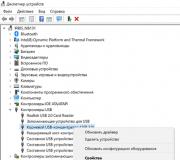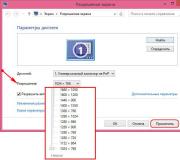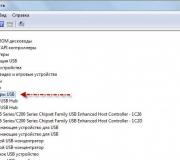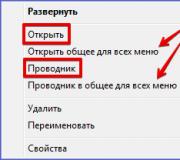How to clear your browser's temporary cache. How to clear the browser cache: step by step instructions
Browser loversGoogle Chrome and Operasooner or later you have to face the need to clear the browser cache. This procedure will free up memory on your computer's hard drive and help your browser run faster.
If you have previously heard the phrases: clear the cache, browser cache, but do not know what it means, then you will find the answer to your question in this instruction.
Let's understand what cache memory is.
Cache - (translated from English.cache - pantry, cache) there is also such a term as cache memory - this is a memory area used for temporary storage of data. The browser has faster access to the cache memory than, for example, access to data on the Internet, so it can load sites that you have previously visited faster.
So on the hard drive of your computer, a bunch of pictures, media files, books, sites that you viewed earlier are probably already stored. All this goodness is stored in a specific folder created by the Internet browser during installation.
For example, if you re-visit your favorite site where you listened to music, the browser will find them in this folder and load the files from the cache, thereby speeding up the opening of the file and you will not have to wait. This is relevant if you do not have a fast enough Internet connection or have problems with the site itself.
The browser cache must be cleared if the content of the site began to display incorrectly, an error appears400 bad request or slowdowns appeared when downloading files, viewing photos, videos and movies online, listening to music.
It is also periodically necessary not to keep all the garbage accumulated by the browser.
Since there can be not only media files, but also malware and viruses.
Consider two ways to clear the cache memory .
- using hotkeys:
While working in the browser, simultaneously press the following combinationShift+Ctrl+Delete e
- through the browser menu.
In order to enter the browser menu, click on the button with three horizontal dots.
A drop-down menu will open in which you need to select the "Settings" item 
Next, you will be taken to the settings menu, in which we are looking for the item “Show advanced settings” 

From the proposed list, we tick off the items we need. In our case, put a tick in front of the "Clear Cache" item, and also select the time interval. For example, I always choose "All time" to immediately remove all the garbage.

As you can see, there are no difficulties in clearing the cache memory of the Google Chrome browser. I also recommend that you do not limit yourself and check off such items as “Download History” and “View History”, but I do not advise you to check the “Passwords” and “Autofill Data” items, since in the future you will have to remember and enter all logins and passwords again. I think many will not be particularly happy about this and incorrectly marked items will bring you unnecessary trouble.
We will also consider below how you can perform the above procedure in a browser. Therefore, if you, like me, use opera, then be sure to read it.
How to clear the cache in opera
In opera, the cache can be cleared in a similar way as in Google Chrome, but there are some nuances that I want to tell you about. We will also consider two cleaning methods: using the browser menu, as well as by installing a special extension that can be downloaded using the browser's built-in search.
In order to clear the cache memory, you need to click on the "Menu" button, which is located in the upper left corner. A drop-down list will appear in which we are looking for the "Settings" item.

If you actively use hotkeys, then in the opera browser, you can go to the settings by pressing the key combination ALT + P
The Opera settings panel will open in front of you, we are interested in the item "Security".
You can find this section in the left column, it contains all the personal browser user settings, such as auto-completion of passwords and forms, browsing history management, and the item we need to clear the cache.
In the window that opens, we are interested in the button "Clear browsing history" 
In the window that opens, check the "Cached images and files" checkbox and click the "Clear browsing history" button

Do not forget to select the time interval for which you want to delete the cache. If you need to delete all the accumulated data, then select "From the beginning". This is how you can clear the cache in the opera, but this method is suitable for those who do not use this function so often, if you need to perform this procedure all the time, then I recommend using a special SingleClick Cleaner extension for this purpose, which can be easily installed using the information below .
In order to install the extension any extension, go to the Opera browser menu.
Next, look for the item "Extensions" click on it and in the left item click "Manage extensions" or simply press the key combination Ctrl + Shift + E 
Since we need to download a new extension, we are looking for the “Add new extension” item, a browser window will open in which we need to enter the name of the plugin we need in the search bar.

After the search finds SingleClick Cleaner, click the green Add to Opera button 
Once the extension is installed, a trash can icon will appear on the browser toolbar. In order to use the new function in the future, we will need to configure the plugin once, so that in the future the procedure takes as little time as possible. To do this, click on the trash can icon, a menu will appear in which you need to select from the list what data we will clear, as well as the time for which the accumulated data should be deleted. If you need to clear the cache for all the time in the opera, then select the item "Empty the cache" and "the dawn of time".
Surely you have often heard the phrase - clear the cache. Allegedly, this will increase the speed of the computer in operation. To some extent this is true, but what is the Windows CACHE and where can I find it? The word itself comes from the English verb cacher, that is, “to hide”.
Therefore, we are talking about files that are securely hidden from the user's eyes. Indeed, you need to shovel a lot of folders in order to clear the entire CACHE of a computer running Windows 7, XP or another version. But there are also easier ways.
General concepts
There are at least 4 types of cache:
- browser;
- file thumbnails;
- RAM (Random Access Memory).
In addition, some programs in the course of their work can create their own temporary files. To remove them, just clear the RAM CACHE.
Before proceeding with the consideration of cleaning methods, it is worth answering the question - what gives Windows itself or the work on the computer the removal of these invisible files? In most cases, the browser's cache, for example, is a huge number of small files that accumulate during computer operation.
We watched an online video and it is already in the cache and will be there until a reboot or manual clearing. Launched the game and it took up most of the RAM. But when you exit the game, some of it may still be occupied. The same is true for some programs. In this case, the RAM may not be enough for other tasks. Yes, and on the hard drive, temporary files without cleaning for a long time begin to take up gigabytes of memory.
Why put up with it when you can clear the cache quickly and easily?
Browser methods
In this case, there is no single recipe. Different programs offer their variations. You can clear temporary files in your browser by going to its settings. In Google Chrome, the required item is called “Clear History”.
Be careful: you can choose to clear the cache only or delete saved passwords, browsing history, site settings, and so on at the same time.
For Internet Explorer, this option is referred to as "Delete Browsing History", and for Firefox - "Clear Recent History".
Method for clearing memory
To unload RAM from unnecessary trash and speed up your computer, first look at the address: Start - Computer (right-click) - Properties. If your Windows is 32-bit, open Start again and run the Run program.
In a new window, copy the command:
%windir%\system32\rundll32.exe advapi32.dll,ProcessIdleTasks

and complete. Memory cleared! For 64-bit Windows, use the following command:
%windir%\SysWOW64\rundll32.exe advapi32.dll,ProcessIdleTasks
Methods for DNS cache
We are talking about saved data regarding computer requests to Internet servers. If you want to completely clear this history, follow these simple steps:
- Open Start.
- Go to All Programs - Accessories.
- Run Command Prompt as administrator (right click).
- In the window, type ipconfig /flushdns and press Enter. Ready!

What is browser cache? How to clean it? Probably a lot of people have experienced this problem. Clear your browser cache often, and your computer will load and work on the Internet much faster. The very concept of a cache is very voluminous, but we will consider only the browser cache.
While working on the Internet, the browser (Internet Explorer, Opera, Mozilla or other) loads Internet pages, scripts, pictures, sounds, etc., all these files are automatically saved on your computer. They are known as Browser CACHE or temporary Internet files.
In addition to temporary files, browsers store the following information: Cookies; log of visited web sites; information indicated on web pages or in the address bar; saved network passwords; download log; site settings.
All this information is useful when visiting Internet pages again, because. speeds up loading and does not require a password.
But there is another side of the coin: the information stored on the computer can become available to third-party users, making it possible to track the sites you visit, to gain access to your personal information stored on Internet sites. The memory cache not only takes up hard disk space, may contain dangerous files and scripts (intrusive banners, viruses, etc.), but sometimes interferes with the normal operation of the Internet browser itself (buttons, links, etc. stop working on web pages .). Cookies, by tracking information about the websites you visit, can jeopardize the user's privacy.
Consider methods for clearing cache memory using the browser itself.
Clear cache in Opera
1. at the top, open the "Tools" tab, then "Settings"

In the window that opens, select Extended_History and next to the Disk Cache inscription, click Clear:

In order to clear Cookies, click in the same window on Cookies_Manage Cookies:

In the window that opens, “drive in” the site whose cookies we want to clear, then select the entries and click Delete:

Now everything should fall into place. Be careful, as you can inadvertently delete all previously saved passwords and login data for certain Internet resources.
In the 11th version of OPERA, everything is quite simple: Menu - Settings - Delete personal data

I. Clearing cache memory using browser tools.
Mozilla Firefox1. Open a blank tab
2. Close all open tabs, leaving only an empty one open
3. From the menu, select Tools - Options
4. In the window that opens, click on the "Advanced" tab
5. Select the "Network" tab
6. Click the "Clear Now" button

To delete cookies, in the same window, click:
1. "Privacy" tab (Tools - Start Private Browsing)
2. "Show cookies" button
3. "Delete all cookies" button

I do not advise you to completely disable cookies and set the browser cache to less than 50MB, because. after that, many sites will not work normally.
Internet Explorer
Open "Internet Options", this can be done in the browser itself by clicking Tools - Internet Options, or in the "Control Panel" Start - Control Panel - Internet Options.

Clearing cache memory using browser tools Google Chrome
1. Click on the "wrench" in the right corner
2. Select the "Advanced" tab
3. Click the "Delete browsing data ..." button

Clearing the cache in Safari
Clearing the cache in the Apple Safari browser is quite simple - you need to open the Edit menu and select Clear Cache from it. It remains only to click Clear!
More
From the browser menu, select safari → Reset Safari.
In the menu that opens, enable only the option Delete all website data, then click the button Reset.
Clearing the cache memory using the Yandex browser
Where is the cache located?
The location of the Yandex browser cache depends on your operating system.
Windows 7, Windows 8
Windows XP
Windows Vista
Clear cache
To clear the cache, follow these steps:
Advice. Also open window Clear the history ctrl + Shift + Del(on Windows) or ⌘ + Shift + Del(in MacOS).
More
Clearing cache memory using browser tools - New Yandex Browser
To clear the cache, follow these steps:
Note. open window Clear the history can be done with keyboard shortcuts ctrl + Shift + Del(on Windows) or ⌘
+ Shift + Del(in MacOS).
Cache location
If you need to view or copy the Yandex browser cache (for example, to send it to technical support), you can find it in the following folders:
Operating systemCache address
Windows 7, Windows 8
C:\Users\Your account name\AppData\Local\Yandex\YandexBrowser\User Data\Default\Cache
Windows XP
C:\Documents and Settings\Your account name\Local Settings\Application Data\Yandex\YandexBrowser\User Data\Default\Cache
Windows Vista
C:\Users\Your account name\AppData\Local\Yandex\YandexBrowser\User Data\Default\Cache
MacOS
~/Library/Application Support/Yandex/YandexBrowser/Default/GPUCache
Now you know how to clear the cache in different browsers if the need arises.
A small amount of memory on your hard drive is the browser's cache, which is designed to store fragments of visited sites. The ability of the Internet browser to save images and other content allows you to quickly establish contact with web page servers and save bandwidth. When you regularly visit a large number of sites, a lot of unnecessary files remain on your computer, which slow down your work. To fix this problem, you need to know how to clear the browser cache. This procedure does not imply anything complicated. Let's look at it in more detail.
How to clear browser cache
The function of deleting saved data is provided in all Internet browsers. The creators of each browser have developed a special interface for completely or partially clearing the temporary information of web pages. All that needs to be done for this is to open the corresponding program window and indicate which files need to be erased. For each Internet browser, this procedure is carried out according to a special algorithm. The following sections of this article discuss in detail how to clear temporary content from the most common Internet browsers.
Yandex (Yandex)
A step-by-step guide for those who do not know how to delete the Yandex Browser cache:
- open the menu by clicking on the button located in the upper right corner of the Yandex Internet browser window;
- in the list that appears, find the item "Advanced" and go to it;
- the following drop-down menu will open, from which you need to select the "Clear history" section;
- when the program offers several options for deleting saved data, select the one that is more suitable (for example, “for all time”, or “for the last hour”);
- so that files are deleted along with the history of visiting sites, activate the option "Files saved in the cache";
- disable options that are not needed;
- Confirm the deletion of your browsing data by clicking the "Clear History" button.
Opera (Opera)
The instructions below describe in detail how to clear the cache of the Opera browser version 12 and higher:

- click the "Opera" button located at the top, to the left of the tab bar;
- in the drop-down menu that appears, find the “Settings” section;
- the next menu block will offer several options, from which you need to select the "General Settings" section;
- in the window that opens, go to the "Advanced" section;
- in the left part of the options window, find the item "History" and go to it;
- among the options that appear, find the "Disk Cache" section, then click on the "Clear" button located opposite it;
- for convenience, you can check the “Clear on exit” box so that at each end of the session using the Internet browser, the program will automatically delete the saved data.
Mozilla Firefox (Mozilla)
If you do not know how to clear the cache in the Mozilla Firefox browser, follow the instructions below:

- on the menu bar located above the address bar of the Mozil Internet browser, find the "Tools" item and go to it;
- a drop-down list will appear from which you need the “Settings” section;
- in the window that opens, go to the "additional" section and open the "Network" tab;
- among the list of options, find the "Offline storage" section, and select the "Clear now" option.
Alternatively, you can refer to the keyboard shortcut "Ctrl+Shift+H". This combination will allow you to clear the data saved recently from the temporary memory section of the program. To view the history of visiting sites and delete some sites along with files downloaded from them, press "Ctrl + H". These combinations work in all versions of the Mozilla browser. If this does not help speed up the browser, check the current version of the program. It may be outdated and needs to be updated.
Google Chrome (Google Chrome)
This Internet browser is considered one of the fastest, but if it starts to “slow down”, it means that it needs cleaning. The instructions below describe in detail how to delete the cache in chrome:

- open the settings panel by clicking on the button located at the top of the program window, on the right;
- select "Tools";
- then a menu block will appear in which you need to select the item "Show advanced settings", and then click "Clear history";
- when the window of options for deleting data about visiting pages opens, specify the period for which the information needs to be erased;
- next to the block "Images and other files saved in the cache", check the box;
- make sure the rest of the checkboxes are unchecked;
- confirm the deletion of data by pressing the "Clear history" button.
You just learned how to clear the cache in the Google Chrome browser. If you need to reset the history of visiting web pages, check the corresponding box in the saved data management window. Also, you should know that if you use the browser in incognito mode (hotkey - "Shift + Ctrl + N"), it will not store information about the visited sites. This feature will be useful if you have to sit down at someone else's computer or laptop for a while.
Internet Explorer (Internet Explorer)
The standard web browser from Windows cannot boast of outstanding features. However, many people use it. Temporary Internet Explorer content is cleared according to the following algorithm:

- open the program menu and select the "Tools" item (if the program menu is not displayed, by default, press "Alt");
- in the section that opens, select "Delete browsing history";
- after that, a window will appear in which you need to check the box next to the "Temporary Internet files" block;
- make sure all other checkboxes are unchecked (unless you need to delete anything else besides temporary data), and confirm the action by clicking the "Delete" button.
Safari (Safari)
If you have not changed the default settings of the Safari web browser, the folder with temporary files will be located in the "Documents and Settings" directory, the "[Username]\Local Settings\Application Data\Apple\Safari" directory. Follow the simple instructions and understand how to clear the cache in the Safari browser:

- in the main menu of the Internet browser, select "reset Safari";
- when the options window appears, check the box "Delete all website data";
- make sure that all other checkboxes are unchecked (if you do not need to delete anything other than cache files);
- Confirm the data clearing operation by pressing the "Reset" button.
Video: what is the cache and how to clear it
This video will explain in detail to the Internet user how the system for saving temporary files works, and what it means to clear the browser cache. After watching this video below, you will understand how to delete temporary data of web pages you visit to make your Internet browser work faster. Just follow the recommendations, and you can quickly solve many problems.
Very often, problems in the operation of the PC are connected precisely with this.
The cache is present on any Windows computer In short, it is a store of temporary and service files and components that fills up as you use your PC.
When a lot of software is installed on the computer that you actively use on a daily basis, more and more files are collected in the cache.
They are not automatically deleted, and over time, the storage turns into a real dump of useless temporary data.
Types of cache
There are 2 types of cache: DNS and directly temporary files.
In addition, when using the Internet, temporary files from the network accumulate on the computer - browser cache.
The first type is the data used by the system to convert a numeric IP parameter into a textual domain name.
Thus, access to the Internet resource is faster, since the data is taken from the local receptacle, where they were saved when you first visited the site.
The second type includes update files, installation and temporary data that are stored on the system drive.
Not only do they slow down your PC, but they take up valuable space.
Removing excess rubbish
There are several ways to clear the cache on your computer. And if the DNS is cleared in moments, then it will take more time to remove the system one.
In addition, it will be difficult for novice users to figure it out.
The DNS cache is removed as follows:
- press the key combination Win + R;
- enter in the cmd field, the command line will appear;
- in the window that appears, enter ipconfig /flushdns.
How to clear the PC cache in a few minutes?
A profitable alternative to manual cleaning are special programs for the care of the system. One of the most effective is "Computer Accelerator".
You can download it completely free of charge at http://fast-computer.su.

From similar software "Accelerator" differs, first of all, in simplicity.
The program interface consists of several tabs, each of which is responsible for its part of the work of cleaning the system.

With the help of the program you can:
- completely clear the cache of the system, browsers and other "junk" files;
- check the system registry for unnecessary entries and erase them, while there is a function to save a backup copy;
- correct autoload and remove programs that you do not need immediately after loading;
- view system information, find duplicates and large files.

In addition, a scheduler is provided, with which you can automate all processes by setting the frequency and time of their implementation.
The accelerator in the background will carry out manipulations without distracting the user.




